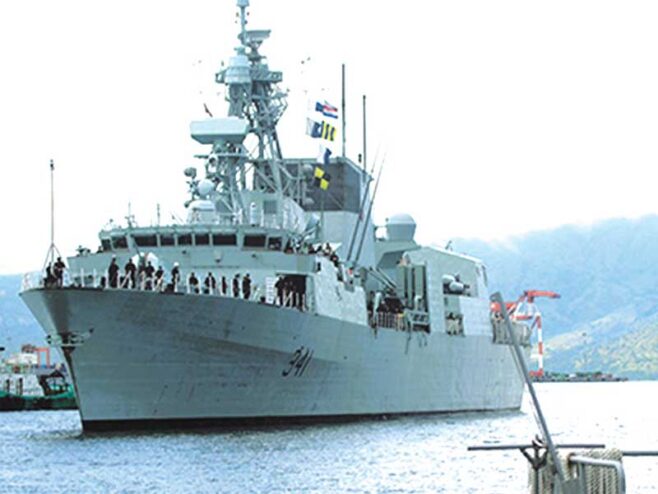A Royal Canadian Navy frigate steamed into Subic Bay in the Philippines on September 14, 2023.
The arrival of the Halifax-class warship came days after it was reportedly shadowed by Chinese warships while transiting the Taiwan Strait north of the Philippines in a joint maneuver with a United States Navy destroyer.
The frigate was welcomed by officials of the Subic Bay Metropolitan Authority, led by its chair and administrator, Jonathan Tan.
A statement from the Canadian Embassy said His Majesty’s Canadian Ship (HMCS) Ottawa (FFH 341) will be the first of three Canadian ships to visit the Philippines this month.
This as the Royal Canadian Navy (RCN) conducts a goodwill visit as part of Canada’s defense engagement in the Indo-Pacific region.
“The arrival of HMCS Ottawa is a demonstration of the close and growing relationship between Canada and the Philippines, and of Canada’s commitment to stability and security in Southeast Asia and the broader Indo-Pacific region,” a statement attributed to Canada’s Ambassador to the Philippines David Hartman said.
“As maritime nations, Canada and the Philippines share a common interest in upholding a rules-based international order, and maintaining a free and open Indo-Pacific,” Hartman was also quoted as saying.
HMCS Ottawa was scheduled to be docked in Subic until September 19.
The ship has just completed Exercise Noble Wolverine at the South China Sea, alongside the Arleigh Burke-class guided-missile destroyer USS Ralph Johnson (DDG 114), according to a report by the US Navy Office of Information.
Lt. Cmdr. Seth Koenig, commander of the US Navy’s Task Force 71/Destroyer Squadron 15, said in the report that “Noble Wolverine” exercise involved sustained Surface Action Group (SAG) operations intended to improve interoperability between the allied navies and support a free and open Indo-Pacific.
Both the Canadian Embassy statement and the US Navy report did not mention surveillance by Chinese warships during the exercise, but a September 9 story ran by the US Naval Institute (USNI).
While in Subic, the HMCS Ottawa crew was to conduct interaction with locals, including professional development opportunities with the Philippine Navy, community outreach, and local engagements such as a fun run and an exchange of ship’s cooks.
“Through our ongoing engagements in the Indo-Pacific, the Royal Canadian Navy is reinforcing partnerships with navies from across the region,” the Canadian statement quoting Ottawa’s commanding officer Samuel Patchell said.
“I look forward to working closely with the Philippine Navy throughout our visit to Subic Bay in pursuit of our shared goal of a free and open Indo-Pacific,” Patchell added.
The Canadian frigate has a complement of 225, including an air detachment, and is armed with 24 Honeywell torpedoes, 16 Evolved-Sparrow surface-to-air missiles, 8 Harpoon surface-to-surface missiles, one 57mm Bofors Mark gun, one 20mm Vulcan Phalanx close-in weapons system, six .50-caliber machine guns, and a Sikorsky CH-148 Cyclone helicopter.
The Canadian Embassy said that HMCS Ottawa has been deployed since August, and that Subic Bay is its second port visit.
Throughout the last quarter of 2023, HMCS Ottawa will conduct forward naval presence operations, cooperative deployments and participate in international naval exercises with partner nations, the statement added.
Meanwhile, a second Canadian vessel, the MV Asterix, an auxiliary supply vessel leased to the RCN, was scheduled to arrive in Subic Bay on September 16.
A third Canadian ship, the HMCS Vancouver, is scheduled to arrive in Manila at the end of September.








